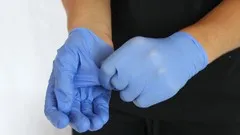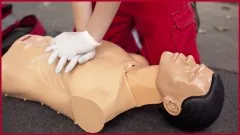
StudiGuide 34: CPR and First Aid 
This StudiGuide course provides a comprehensive review-testing resource for police academy cadets to help understand and pass the POST written examinations. It covers topics such as the primary responsibilities of peace officers as EMS first responders, the links of the chain of transmission of infectious pathogens, conditions under which a peace officer is protected from liability when providing emergency medical services, assessment criteria for establishing priorities when assessing multiple victims at a single scene, the components of the Chain of Survival, and more. It also covers topics such as Low blood sugar (hypoglycemia) and High blood sugar (hyperglycemia), Hypothermia and frostbite, Heat cramps heat exhaustion and heat stroke, first aid equipment and precautions, proper procedures for moving a victim, the signs and symptoms of shock, indicators of a possible head injury, and more. This course is perfect for police academy cadets looking to understand and pass the POST written examinations. ▼
ADVERTISEMENT
Course Feature
![]() Cost:
Cost:
Free
![]() Provider:
Provider:
Udemy
![]() Certificate:
Certificate:
No Information
![]() Language:
Language:
English
![]() Start Date:
Start Date:
2020-03-23
Course Overview
❗The content presented here is sourced directly from Udemy platform. For comprehensive course details, including enrollment information, simply click on the 'Go to class' link on our website.
Updated in [August 18th, 2023]
Skills and Knowledge:
This StudiGuide course will provide participants with the skills and knowledge to identify the primary responsibilities of peace officers as EMS first responders and at an emergency, the links of the chain of transmission of infectious pathogens, conditions under which a peace officer is protected from liability when providing emergency medical services, assessment criteria for establishing priorities when assessing multiple victims at a single scene, the components of the Chain of Survival, the difference between a mild and severe airway obstruction, appropriate first aid measures for treating injuries or wounds to the bones, muscles, soft tissues or joints, signs and symptoms of psychological emergencies, indicators and first aid measures for treating low blood sugar (hypoglycemia) including assisted glucose administration, high blood sugar (hyperglycemia), hypothermia and frostbite, heat cramps, heat exhaustion and heat stroke, first aid equipment and precautions peace officers may utilize to treat others and to ensure their own personal safety when responding to an emergency, conditions under which an injured victim should be moved from one location to another, proper procedures for moving a victim, circumstances under which a victim's airway should be opened by using a head-tilt&chin-lift maneuver and jaw-thrust maneuver, the signs and symptoms of shock, indicators of a possible head injury, the appropriate first aid measures for treating facial injuries to include objects in the eye, chemicals in the eye, dental emergency, nose bleed, appropriate first aid measures for treating open and closed injuries to the chest and abdomen, appropriate first aid measures for treating injuries to the head, neck and back including spinal immobilization, appropriate first aid measures for treating Thermal Chemical Electrical and Radiation burns, appropriate first aid measures for a victim experiencing signs of poisons that have been ingested, inhaled, absorbed or injected; alcohol and&or drug-related emergencies including assisted Naloxone administration and accessing EMS, appropriate first aid measures for insect bites and stings; animal and human bites, the signs of imminent birth, appropriate first aid measures for each of the following emergency situations that may occur in childbirth such as excessive vaginal bleeding and newborn fails to breathe, indicators of and first aid measures for a victim experiencing cardiac emergency, respiratory emergency including asthma and Chronic Obstructive Pulmonary Disease (COPD), drowning, seizure, stroke, altered mental status, severe abdominal pain, allergic reactions and anaphylaxis (assisted epinephrine administration accessing EMS), the components of the EMS system including EMS access interaction with other EMS personnel local EMS and trauma systems, Basic Automated External Defibrillator (AED) operation including special considerations troubleshooting, rescue breathing techniques when using mouth-to-mouth pocket mask or other barrier device bag valve mask, recovery position, bleeding control techniques to include direct pressure&pressure dressings tourniquet types of hemostatic dressings and packing the wound, first aid measures to treat shock including the importance of maintaining normal body temperature, tactical and rescue first aid principles when responding to violent circumstances (eg active shooter) movement to threat versus casualty care integration with EMS tactical casualty care, appropriate actions to take during a primary assessment for assessing both conscious and unconscious victims Responsiveness Airway Breathing Circulation, appropriate actions to take during a primary assessment for assessing both conscious and unconscious victims Vital Signs Head to toe assessment Patient history, Cardiopulmonary Resuscitation (CPR) for adults children and infants following current American Heart Association (AHA) Guidelines for CPR and Emergency Cardiovascular Care (ECC) at the healthcare provider level including Ventilation duration Pulse location Compression depth Compression rate Compression-to-ventilation ratio (one-person CPR) Compression-to-ventilation ratio (two-person CPR) Automated External Defibrillator (AED) procedures for clearing an obstruction from the airway of both a conscious and an unconscious Adult Child Infant Pregnant or obese individual, the general guidelines for controlling bleeding from an open wound, first aid measures to treat shock, and tactical and rescue first aid principles when responding to violent circumstances. Participants will also demonstrate appropriate actions to take during a primary assessment for assessing both conscious and unconscious victims, Cardiopulmonary Resuscitation (CPR) for adults children and infants following current American Heart Association (AHA) Guidelines for CPR and Emergency Cardiovascular Care (ECC) at the healthcare provider level, Automated External Defibrillator (AED) procedures for clearing an obstruction from the airway of both a conscious and an unconscious Adult Child Infant Pregnant or obese individual, the general guidelines for controlling bleeding from an open wound, and first aid measures to treat shock.
Professional Growth:
This StudiGuide course provides a comprehensive review of the primary responsibilities of peace officers as EMS first responders and at an emergency, the links of the chain of transmission of infectious pathogens, conditions under which a peace officer is protected from liability when providing emergency medical services, assessment criteria for establishing priorities when assessing multiple victims at a single scene, the components of the Chain of Survival, the difference between a mild and severe airway obstruction, appropriate first aid measures for treating injuries or wounds to the bones, muscles, soft tissues or joints, signs and symptoms of psychological emergencies, indicators and first aid measures for treating low and high blood sugar, hypothermia and frostbite, heat cramps, heat exhaustion and heat stroke, first aid equipment and precautions, proper procedures for moving a victim, circumstances under which a victim's airway should be opened, the signs and symptoms of shock, indicators of a possible head injury, the appropriate first aid measures for treating facial injuries, dental emergency, nose bleed, open and closed injuries to the chest and abdomen, injuries to the head, neck and back including spinal immobilization, Thermal Chemical Electrical and Radiation burns, first aid measures for a victim experiencing signs of poisons, alcohol and/or drug-related emergencies, insect bites and stings, animal and human bites, signs of imminent birth, cardiac emergency, respiratory emergency, drowning, seizure, stroke, altered mental status, severe abdominal pain, allergic reactions and anaphylaxis, Basic Automated External Defibrillator (AED) operation, rescue breathing techniques, bleeding control techniques, tourniquet, hemostatic dressings, packing the wound, tactical and rescue first aid principles, primary assessment for assessing both conscious and unconscious victims, Vital Signs, Head to toe assessment, Patient history, Cardiopulmonary Resuscitation (CPR) for adults, children and infants, Automated External Defibrillator (AED) procedures, general guidelines for controlling bleeding from an open wound, and tactical casualty care.
This StudiGuide course contributes to professional growth by providing a comprehensive review of the knowledge and skills necessary for peace officers to respond to emergency medical situations. It provides a practice review-testing resource to help understand and pass the POST written examinations, and covers topics such as the primary responsibilities of peace officers as EMS first responders, the links of the chain of transmission of infectious pathogens, conditions under which a peace officer is protected from liability when providing emergency medical services, assessment criteria for establishing priorities when assessing multiple victims at a single scene, the components of the Chain of Survival, the difference between a mild and severe airway obstruction, appropriate first aid measures for treating injuries or wounds to the bones, muscles, soft tissues or joints, signs and symptoms of psychological emergencies, indicators and first aid measures for treating low and high blood sugar, hypothermia and frostbite, heat cramps, heat exhaustion and heat stroke, first aid equipment and precautions, proper procedures for moving a victim, circumstances under which a victim's airway should be opened, the signs and symptoms of shock, indicators of a possible head injury, the appropriate first aid measures for treating facial injuries, dental emergency, nose bleed, open and closed injuries to the chest and abdomen, injuries to the head, neck and back including spinal immobilization, Thermal Chemical Electrical and Radiation burns, first aid measures for a victim experiencing signs of poisons, alcohol and/or drug-related emergencies, insect bites and stings, animal and human bites, signs of imminent birth, cardiac emergency, respiratory emergency, drowning, seizure, stroke, altered mental status, severe abdominal pain, allergic reactions and anaphylaxis, Basic Automated External Defibrillator (AED) operation, rescue breathing techniques, bleeding control techniques, tourniquet, hemostatic dressings, packing the wound, tactical and rescue first aid principles, primary assessment for assessing both conscious and unconscious victims, Vital Signs, Head to toe assessment, Patient history, Cardiopulmonary Resuscitation (CPR) for adults, children and infants, Automated External Defibrillator (AED) procedures, general guidelines for controlling bleeding from an open wound, and tactical casualty care. By providing a comprehensive review of the knowledge and skills necessary for peace officers to respond to emergency medical situations, this course contributes to professional growth.
Further Education:
This StudiGuide course provides a comprehensive review of the primary responsibilities of peace officers as EMS first responders and at an emergency, the links of the chain of transmission of infectious pathogens, conditions under which a peace officer is protected from liability when providing emergency medical services, assessment criteria for establishing priorities when assessing multiple victims at a single scene, the components of the Chain of Survival, the difference between a mild and severe airway obstruction, appropriate first aid measures for treating injuries or wounds to the bones, muscles, soft tissues or joints, signs and symptoms of psychological emergencies, indicators and first aid measures for treating low and high blood sugar, hypothermia and frostbite, heat cramps, heat exhaustion and heat stroke, first aid equipment and precautions, proper procedures for moving a victim, circumstances under which a victim's airway should be opened, signs and symptoms of shock, indicators of a possible head injury, appropriate first aid measures for treating facial injuries, dental emergency, nose bleed, chest and abdomen injuries, head, neck and back injuries, Thermal, Chemical, Electrical and Radiation burns, appropriate first aid measures for a victim experiencing signs of poisons, alcohol and/or drug-related emergencies, insect bites and stings, animal and human bites, signs of imminent birth, appropriate first aid measures for each of the following emergency situations that may occur in childbirth, cardiac emergency, respiratory emergency, drowning, seizure, stroke, altered mental status, severe abdominal pain, allergic reactions and anaphylaxis, Basic Automated External Defibrillator (AED) operation, rescue breathing techniques, bleeding control techniques, tourniquet, hemostatic dressings, components of the EMS system, tactical and rescue first aid principles, primary assessment for assessing both conscious and unconscious victims, Vital Signs, Head to toe assessment, Patient history, Cardiopulmonary Resuscitation (CPR) for adults, children and infants, Automated External Defibrillator (AED) procedures, general guidelines for controlling bleeding from an open wound, and first aid measures to treat shock.
This StudiGuide course is suitable for preparing further education in the field of emergency medical services. It provides a comprehensive review of the topics related to peace officers as EMS first responders and at an emergency, the links of the chain of transmission of infectious pathogens, conditions under which a peace officer is protected from liability when providing emergency medical services, assessment criteria for establishing priorities when assessing multiple victims at a single scene, the components of the Chain of Survival, the difference between a mild and severe airway obstruction, appropriate first aid measures for treating injuries or wounds to the bones, muscles, soft tissues or joints, signs and symptoms of psychological emergencies, indicators and first aid measures for treating low and high blood sugar, hypothermia and frostbite, heat cramps, heat exhaustion and heat stroke, first aid equipment and precautions, proper procedures for moving a victim, circumstances under which a victim's airway should be opened, signs and symptoms of shock, indicators of a possible head injury, appropriate first aid measures for treating facial injuries, dental emergency, nose bleed, chest and abdomen injuries, head, neck and back injuries, Thermal, Chemical, Electrical and Radiation burns, appropriate first aid measures for a victim experiencing signs of poisons, alcohol and/or drug-related emergencies, insect bites and stings, animal and human bites, signs of imminent birth, appropriate first aid measures for each of the following emergency situations that may occur in childbirth, cardiac emergency, respiratory emergency, drowning, seizure, stroke, altered mental status, severe abdominal pain, allergic reactions and anaphylaxis, Basic Automated External Defibrillator (AED) operation, rescue breathing techniques, bleeding control techniques, tourniquet, hemostatic dressings, components of the EMS system, tactical and rescue first aid principles, primary assessment for assessing both conscious and unconscious victims, Vital Signs, Head to toe assessment, Patient history, Cardiopulmonary Resuscitation (CPR) for adults, children and infants, Automated External Defibrillator (AED) procedures, general guidelines for controlling bleeding from an open wound, and first aid measures to treat shock.
Course Syllabus
StudiGuide 34: How To Pass This Written Examination
StudiGuide 34: OVERVIEW to CPR and First Aid
StudiGuide 34: Law Enforcement and Emergency Medical Services
StudiGuide 34: Victim Assessment
StudiGuide 34: Basic Life Support
StudiGuide 34: Traumatic Injuries
StudiGuide 34: Medical Emergencies
StudiGuide 34: Childbirth
Updates to StudiGuide 34 / March 2019
StudiGuide 34: Final Review Questions for CPR and First Aid
Course Provider

Provider Udemy's Stats at AZClass
Discussion and Reviews
0.0 (Based on 0 reviews)
Explore Similar Online Courses

Understanding Key Account Management

Marketing and Growing Your Udemy Course (Unofficial)

Python for Informatics: Exploring Information

Social Network Analysis

Introduction to Systematic Review and Meta-Analysis

The Analytics Edge

DCO042 - Python For Informatics

Causal Diagrams: Draw Your Assumptions Before Your Conclusions

Whole genome sequencing of bacterial genomes - tools and applications

First Aid and Bloodborne Pathogens (BBP)

2 How To Save A Life - Advanced


Start your review of StudiGuide 34: CPR and First Aid